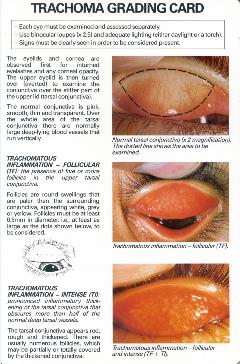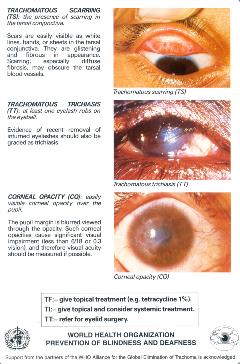Diagnosis
In areas where trachoma is endemic, active (inflammatory) trachoma is common among preschool-aged children. The prevalence in this age group can be as high as 60–90%. Conjunctival Chlamydia trachomatis infection and the associated signs of active trachoma become less frequent and shorter in duration with increasing age.
Infection is usually acquired through living in close proximity to others with active disease, and the family is the principal unit for transmission. An individual’s immune system can clear a single episode of infection, but in endemic communities, re-acquisition of the organism occurs frequently.
After years of repeated infection, the inside of the eyelid can become so severely scarred (trachomatous conjunctival scarring) that the eyelid curls inwards and causes the eyelashes to rub against the eyeball (trachomatous trichiasis), resulting in pain and light intolerance; this and other alterations of the eye can lead to the scarring of the cornea. Left untreated, this condition leads to the formation of irreversible opacities, with resulting visual impairment or blindness. The age at which this occurs depends on several factors including local transmission intensity. In very highly endemic communities, it can occur in childhood, though onset between the ages of 30 and 40 years is more typical.
Trachoma is usually clinically diagnosed. People are examined for clinical signs through magnifiers (loupes), with the aid of sunlight or a torch.
The WHO simplified grading system for trachoma has 5 signs:
- Trachomatous inflammation— follicular (TF): The presence of five or more follicles, each at least 0.5 mm in diameter, in the central part of the upper tarsal conjunctiva. (Follicles are round lumps or spots that lie beneath the more superficial epithelium and are paler than the surrounding tissue).
- Trachomatous inflammation— intense (TI): Pronounced inflammatory thickening of the upper tarsal conjunctiva that obscures more than half of the normal deep tarsal vessels.
- Trachomatous scarring (TS): The presence of easily visible scarring in the upper tarsal conjunctiva. Scars appear as white lines, bands, or sheets.
- Trachomatous trichiasis (TT): At least one eyelash from the upper eyelid touches the eyeball, or evidence of recent epilation of in-turned eyelashes from the upper eyelid.
- Corneal opacity (CO): Easily visible corneal opacity that is so dense that at least part of the pupil margin is blurred when viewed through the opacity. In individuals with corneal opacity, visual acuity should be measured, if possible.
Relevant publications
WHO simplified grading card
Related content


